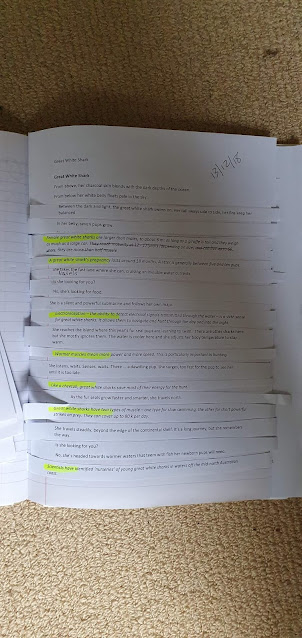 One of my early picture books, There Was an Old Sailor, featured a number of sea creatures from the tiny krill to the
enormous blue whale. The story was based on ‘There Was An Old Woman Who
Swallowed a Fly’ and set in the ocean.
One of my early picture books, There Was an Old Sailor, featured a number of sea creatures from the tiny krill to the
enormous blue whale. The story was based on ‘There Was An Old Woman Who
Swallowed a Fly’ and set in the ocean. The second-largest of the animals swallowed by my sailor was a shark and I found a fabulous, rubbery shark that very closely resembled the great white of Cassandra Allen’s wonderful illustrations.
The shark was grey on top and white on the underneath. When I shared the story, I’d talk about why the shark and many other fish had lighter bellies and darker backs. I found it fascinating, as did my audience.
The more I discovered about the great white shark, the more fascinated I became. I’d written about iconic Australian animals for Walker’s Nature Storybook series including the big red kangaroo, emu and koala. I loved every minute of the research, always searching for information that not many people knew. Then I wrote about the dingo, who featured peripherally in these books. I wanted to understand a bit more about their behaviour but also to showcase their important and necessary place in the ecosystem. I also wanted to share ‘gold-nugget information’ – eg that a dingo’s head is the broadest part of their body. After Dingo, I wrote about the laughing kookaburra. I thought I know a bit about the kookaburra, but I had so much to learn, for example the value of monocular and binocular vision in their hunting.
And so, to the great white shark. Most people seem to gather
at the edges of emotion when it comes to sharks, either fear or
fascination/obsession. I wanted to explore the life and the world of this apex
predator and their importance in the ocean ecology. As always, I scoured my
local library for general and specific information, as well as chased obscure
and detailed research online. This wide and general research helped to shape
the scope and extent of my narrative and the non-fiction that would sit with
it. I asked myself questions like, ‘who is the viewpoint character - male,
female, juvenile?’, ‘What extent will work best – a day, a season, a year?’ and
‘How close can I get without pretending I am a shark?’
As with all of the Nature Storybooks, there’s a narrative exploring a particular journey for this individual animal, and there’s non-fiction information on each opening that’s about the species. Once I’d filled a notebook and an online file with information, and my head was bursting with facts, figures and images, I began drafting the narrative and setting the facts with them. When I was a few drafts in, I cut the manuscript up into individual lines and jig-sawed them into the right order.
It took a long time, but just when I started to think I’d never be able to do it, the mists cleared and the story emerged. This happens with all projects and it’s a wonderful feeling to see a way forward after all the doubt. There was a lot more tweaking and rearranging before it was ready for submission. Then came the fun part – working with my editor, talking with the Walker team about illustrations and illustrators, seeing sketches, roughs, colour images and seeing Cindy’s Lane’s visual narrative taking shape.
And finally, finally, that idea is a book and ready to share
with readers and the fun can begin!
Discover more of Claire's amazing titles and the author herself via her 12 Curly Questions Interview.
If you'd like a copy of Claire's latest Nature Storybooks title, enter our Australiana Picture Book Prize Pack Giveaway this week. Entry is free and the competition is open until this Saturday.




